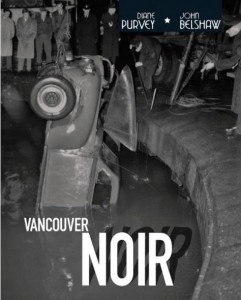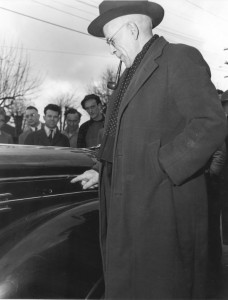Definition of “Noir” from the Free Dictionary: “Of or relating to a genre of crime literature featuring tough, cynical characters and bleak settings. Suggestive of danger or violence. Of or relating to the film noir genre.”
When I wrote At Home with History, the 1930s Strathcona seemed a natural place to start. I talked to people who had lived through that era, had parents who bootlegged to survive, knew the girls from the local brothels, and many of the cops who enforced BC’s crazy liquor laws. That chapter soon morphed into a second and a third on rum runners and liquor barons who lived on the west side of town, and who by their vast wealth remained relatively untouched by a largely corrupt police force.
 I took Will Woods Forbidden Vancouver tour last month, and I recently finished Vancouver Noir, a book that covers a 30 year period through the lens of a camera.
I took Will Woods Forbidden Vancouver tour last month, and I recently finished Vancouver Noir, a book that covers a 30 year period through the lens of a camera.
Authors John Belshaw and Diane Purvey believe that Noir-era values are found in the gritty black and white police and newspaper photographs of the day. Shot by the Speed Graphic camera—a invention of the late ‘20s—the photos feature hard-nosed detectives, murder scenes, bullet-ridden cars, riots and rain slicked streets lit by neon signs.
“What appeals to us about the period 1930-1960 is that there isn’t a lot in the way of progress, in fact, there’s an overall collapse,” says Belshaw. “It’s an era of failure.”
It was a city that produced Walter Mulligan, the top cop on the take, serial Mayor L.D. Taylor, Joe Celona–Vancouver’s own Al Capone, and fruitless wars on vice, racism and poverty.
 “What we tried to do with Vancouver Noir is show Vancouverites a city with big brass balls. A place where gambling joints were everywhere, cops were on the take, and you could get a decent steak dinner and hear some great music anywhere from Hogan’s Alley through the Mandarin Gardens to The Cave,” he says. “This was a city without global ambitions—it was a hard-boiled port town where even the Chief of Police wrote like he was Dashiell Hammett.”
“What we tried to do with Vancouver Noir is show Vancouverites a city with big brass balls. A place where gambling joints were everywhere, cops were on the take, and you could get a decent steak dinner and hear some great music anywhere from Hogan’s Alley through the Mandarin Gardens to The Cave,” he says. “This was a city without global ambitions—it was a hard-boiled port town where even the Chief of Police wrote like he was Dashiell Hammett.”
Belshaw and Purvey argue that it was a period of one moral panic following another. Values were in flux and the growing middle class tried to squash what they saw as deviant behavior.
“We wanted to show that the battle against deviance was a serious business. It took out whole neighbourhoods, justified murders, deported its enemies—this was no imagined confrontation—it’s bare-knuckled stuff,” says Belshaw.
It’s a long way from the glossy tourism photos of English Bay and Grouse Mountain, and it’s a side of Vancouver that will likely surprise most Vancouverites. But it’s as much a part of our make-up as the stories of Gassy Jack and the CPR, and one that I’m betting we’ll be hearing more about from a whole new wave of writers.
For more information see the authors’ blog and Anvil Press.
© All rights reserved. Unless otherwise indicated, all blog content copyright Eve Lazarus.



3 comments on “Vancouver Noir”
[…] around for more dirt on the city they love. She has a few things to say about Vancouver Noir in the latest entry. Share this:ShareLinkedInPinterestEmailPrintFacebookTwitterLike this:LikeBe the first to like this. […]
Your visit around Vancouver sound just like the daily life of the US photographer Weegee who daily used a Speed Graphic to capture the seamy side of life…
Keith
[…] pm John Belshaw and Diane Purvey will speak about their new book Vancouver Noir at the Vancouver Historical Society’s meeting at the Museum of Vancouver. Meetings are free and […]